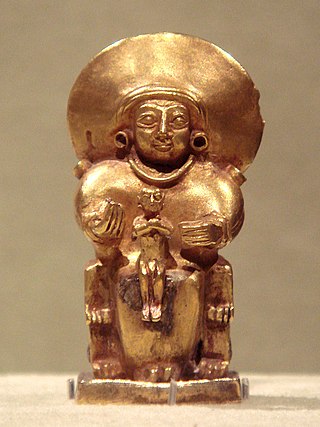Related Research Articles
In ancient Celtic religion, Rudianos was a war god worshiped in Gaul. In Roman times he was equated with Mars.
In Latvian mythology, the term ' stands for "mother", sometimes written in English as Mhte'. It was an epithet applied to some sixty-seventy goddesses. were clearly distinct goddesses in most or all cases, so the term definitely referred to the mother-goddess of specific phenomena. According to professor Lotte Motz, scholar Haralds Biezais mentioned there were at least 70 characters in Baltic religion identified with the title of Mate.
Auseklis is a Latvian god, a stellar deity that represents a celestial body, but possibly not the same as Venus - the first "star" to appear in the mornings on the east side of the sky. He is the third most popular deity in Latvian mythology after Saulė and Mēness, but is almost exclusively mentioned in folk songs.

Shivini, also known as Siuini, Artinis, Ardinis, was a solar god in the mythology of the Iron Age kingdom of Urartu in the Armenian Highlands. He is the third god in a triad with Khaldi and Theispas. The Assyrian god Shamash is a counterpart to Shivini. He was depicted as a man on his knees, holding up a solar disc. His wife was most likely a goddess called Tushpuea who is listed as the third goddess on the Mheri-Dur inscription.
Rundas is the Hittite god of the hunt and of good fortune. His emblem is a double eagle with a hare in each talon.
Djall or Dreq is the personification of evil in Albanian mythology and folklore. The name is used also for a demon of fire.
Verbt or Verb is a fire and wind god in Albanian pagan mythology. By controlling the wind he is able to fan the flames of fire and move water, the opposite element to fire. Also known as Shën Verbti or Rmoria, he was worshiped in northern Albania until recent times.
A god worshiped in pre-Islamic southern Arabia, particularly Sheba. Haubas's advice was often sought via consultation with oracles.

The kulshedra or kuçedra is a water, storm, fire and chthonic demon in Albanian mythology and folklore, usually described as a huge multi-headed female serpentine dragon. The kulshedra is believed to spit fire, cause drought, storms, flooding, earthquakes and other natural disasters against mankind. In Albanian mythology she is usually fought and defeated by a drangue, a semi-human winged divine hero and protector of mankind. Heavy thunderstorms are thought to be the result of their battles.

Ke'let are a type of evil spirit or ogre in Chukchi mythology, also sometimes known as Re'kkenit.

Ördög is a shape-shifting, demonic creature from Hungarian mythology and early Hungarian paganism who controls the dark and evil forces of the world. After Christianization, it was identified with the devil. It is often said in Hungarian mythology that God had help from Ördög when creating the world.

Worship or deification of fire is known from various religions. Fire has been an important part of human culture since the Lower Paleolithic. Religious or animist notions connected to fire are assumed to reach back to such early pre-Homo sapiens times.

Werethekau was an ancient Egyptian deity. She served as the personification of supernatural powers.
Bardha is an Albanian mythological creature. According to old folklore, to propitiate them one strews cakes or sugar on the ground. It is similar to Zana e malit.
The lubia or ljubi is a water and storm demon in Albanian mythology and folklore, usually depicted as a huge multi-headed female serpentine dragon similar to the kulshedra. In Southern Albanian beliefs, she is a storm deity. She is also referred to as ‘mother lubia’.
Perria or Pehria is a fairy-like mountain figure in Albanian mythology and folklore.
Stihi is a fire-breathing storm demon in Albanian mythology and folklore, similar to the kulshedra.
The Supreme Deity of the Yukaghir is called Pon, meaning "Something." Pon controlled all visible phenomena of nature such as the transition from day to night or the rain.
The Dieva Dēli are heavenly beings depicted as the sons of the sky-god Dievs in Latvian mythology.

Seh₂ul and Meh₁not are the reconstructed Proto-Indo-European goddess of the Sun and god of the Moon. *Seh₂ul is reconstructed based on the solar deities of the attested Indo-European mythologies, although its gender is disputed, since there are deities of both genders. Likewise, *Meh₁not- is reconstructed based on the lunar deities of the daughter languages, but they differ in regards to their gender.
References
Citations
- ↑ Lurker, Manfred (2004). The Routledge Dictionary of Gods and Goddesses, Devils and Demons . Routledge. p. 156. ISBN 0203643518.
- ↑ Lurker, Manfred (2004). The Routledge Dictionary of Gods and Goddesses, Devils and Demons . Routledge. p. 206. ISBN 0203643518.